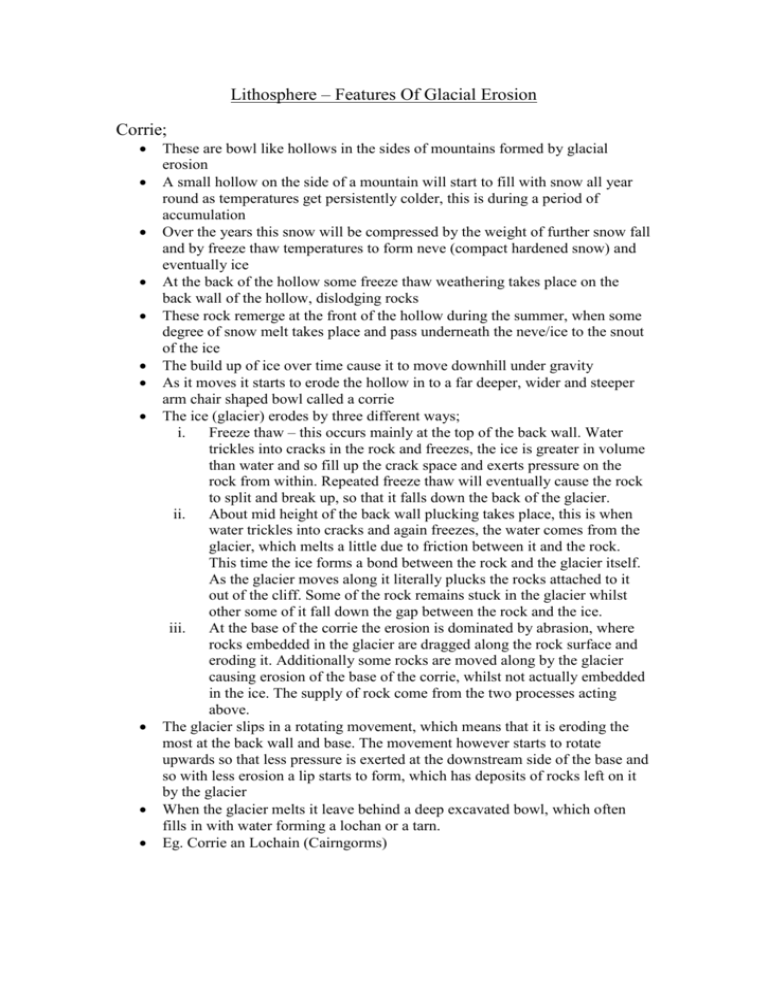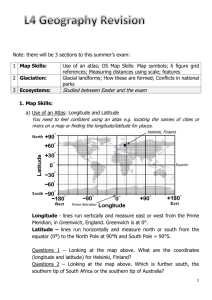Higher Lithosphere Notes On Landforms
advertisement

Lithosphere – Features Of Glacial Erosion Corrie; These are bowl like hollows in the sides of mountains formed by glacial erosion A small hollow on the side of a mountain will start to fill with snow all year round as temperatures get persistently colder, this is during a period of accumulation Over the years this snow will be compressed by the weight of further snow fall and by freeze thaw temperatures to form neve (compact hardened snow) and eventually ice At the back of the hollow some freeze thaw weathering takes place on the back wall of the hollow, dislodging rocks These rock remerge at the front of the hollow during the summer, when some degree of snow melt takes place and pass underneath the neve/ice to the snout of the ice The build up of ice over time cause it to move downhill under gravity As it moves it starts to erode the hollow in to a far deeper, wider and steeper arm chair shaped bowl called a corrie The ice (glacier) erodes by three different ways; i. Freeze thaw – this occurs mainly at the top of the back wall. Water trickles into cracks in the rock and freezes, the ice is greater in volume than water and so fill up the crack space and exerts pressure on the rock from within. Repeated freeze thaw will eventually cause the rock to split and break up, so that it falls down the back of the glacier. ii. About mid height of the back wall plucking takes place, this is when water trickles into cracks and again freezes, the water comes from the glacier, which melts a little due to friction between it and the rock. This time the ice forms a bond between the rock and the glacier itself. As the glacier moves along it literally plucks the rocks attached to it out of the cliff. Some of the rock remains stuck in the glacier whilst other some of it fall down the gap between the rock and the ice. iii. At the base of the corrie the erosion is dominated by abrasion, where rocks embedded in the glacier are dragged along the rock surface and eroding it. Additionally some rocks are moved along by the glacier causing erosion of the base of the corrie, whilst not actually embedded in the ice. The supply of rock come from the two processes acting above. The glacier slips in a rotating movement, which means that it is eroding the most at the back wall and base. The movement however starts to rotate upwards so that less pressure is exerted at the downstream side of the base and so with less erosion a lip starts to form, which has deposits of rocks left on it by the glacier When the glacier melts it leave behind a deep excavated bowl, which often fills in with water forming a lochan or a tarn. Eg. Corrie an Lochain (Cairngorms) Lithosphere – Features Of Glacial Erosion Arete; This a narrow steep sided ridge, which can be found between the sides of two corries The erosional processes of the corrie, freeze thaw, plucking & abrasion mean that corrie walls erode widen, steepen and deepen This means that the sides of the corrie start to migrate backwards and if two corries are side by side they will converge This leaves a narrow ridge between them, which is also very steep and rocky due to freeze thaw processes eg. Striding Edge in The Lake District Pyramidal Peak; This is a sharp pointed mountain formed by three or more corries When three corries form back to back they start to erode the mountain by freeze thaw, plucking & abrasion, which means that the corries they form get steeper, deeper and wider The rock erodes back so that the mountain becomes steeper and the three corrie walls come close enough to converge This leaves a pointed and jagged (freeze thaw) peak eg. The Eiger (The Alps) Glacial Trough; These are deep U shaped valleys fromed by the erosion of valley glaciers As glaciers emerge from the lip of their corries they merge and form a more powerful glacier which erodes more readily They follow the course of former V shaped river valleys As they progress down the valley through their own weight (gravity) they erode like a corrie glacier The top of the valley sides are erode by freeze thaw weathering, mid height of the valley by plucking and the base by abrasion This means that the former V shaped valley will widen, steepen and deepens When a U shaped valley cuts across a water shed it is called a glacial breech The interlocking spurs of the river valley literally have their noses cut off by the ice, leaving a ridge descending into the valley which suddenly steepens, sometimes into an outcrop or a cliff face The steepest part of the valley is often at the trough head (start) where the descending corrie glaciers move quickly under gravity. Other more eroded points tend to be a result of the glacier moving over weaker rock which abrades readily, deepening the base This over deepening can fill in with water leaving a ribbon loch eg, Loch Avon (Cairngorms) Roche Moutonnee; These are rocky hills which have being scrapped and carved by the action of ice They vary in size from 10 to 100m long and from 5 to 100m high They have a long & gentle upstream side (Stoss side), which has been smoothed or polished by abrasion (see corries for details) On this Stoss side there are long thin lines or striations The striations are caused by rocks in the glacier cutting into the rock They are often discontinuous or “chattering” as a result of the unevenness of the rock and glaciers, so that rocks are moving on the rock and then above it etc. The friction between the rock and ice causes heat and melting of some of the ice The resulting water finds it way into joints, where away from the heat caused by friction, the water freezes again The ice forms a link between the cracks of the rock and the moving glacier As the glacier moves it literally plucks out rocks from the bed rock leaving a steeper and jagged downstream side Any freeze thaw action, weakening the jointing of the rock, will only accelerate the process Famous Scottish examples can be found in Glen Nevis by Fort William and Dulnain Bridge by Grantown On Spey. Lithosphere – Features Of Glacial Deposition Terminal Moraines - End Moraines (Till Deposits); These are usually arc shaped ridges made up of rocks deposited by glaciers As a glacier moves along a valley it creates much eroded material, which it transports down the valley a result of freeze thaw, plucking & abrasion This material is transported in several different ways by the glacier; i. On top of the glacier ii. Inside crevasses or cracks in the glacier iii. Dragged along underneath the glacier Additional material accumulates as the glacier bulldozes rock on the valley floor At the maximum extent of the glacier (the furthest point it reaches) much of this eroded material is deposited in a ridge of curving rock The rock deposited is sharp angular rock, which has not been rounded by water action Though rounded rocks can be found, due to the bull dozing of the valley floor, where pre glacial water eroded rocks can be found, the angular rocks dominate this type of deposit The size of such deposits vary greatly from a few metres high to 30-40m high They can be altered by a readvancement of the glacier whereby a colder period sees the glacier grow and move downstream again beyond its previous point, called Push Moraine As a glacier retreats it produces a series of end moraines, one after the other, called recessional moraines A final feature to note is that many of these moraines can trap behind them lochs eg. Corrie an Lochain - Cairngorms Eskers (Fluvio Glacial Deposit); These are narrow, winding and seep sided ridges found in areas, which were either beneath or just beyond the glacier Several can often be found close together, which link together like a braiding stream and unusually can be found travelling both over and down ridges Size wise they can be as high 20-30m and can literally extend for 100’ of Km’s They consist of sand, gravels and pebbles which have been stratified or layered, like a normal stream They are generally thought to be melt water streams found in tunnels underneath and within glaciers, which have developed their own bed loads like any other stream or river As the ice started to waste or melt, the beds were deposited on the valley floor forming ridges The deposition would occur in rather sudden movements, due to the collapsing of the ice, resulting in the disruption of the stratified bed load Good examples can be found around Culloden and Nairn The tunnels that they travel in can go uphill and the water can follow them due to the great pressure created by the flow of the melterwater, called hydrostatic pressure If there is a reduction in flow, deposits can build up, which when deposited from the ice can leave more rounded and wider sections in the esker called a beads Glacial Deposits These are collectively known as Glacial Drift and are split into two groups, those directly deposited by the ice and those which have been associated with water Glacial Drift Till/Boulder Clay Fluvio Glacial Moraines Eskers Drumlins Outwash Sands Erratics Kames







